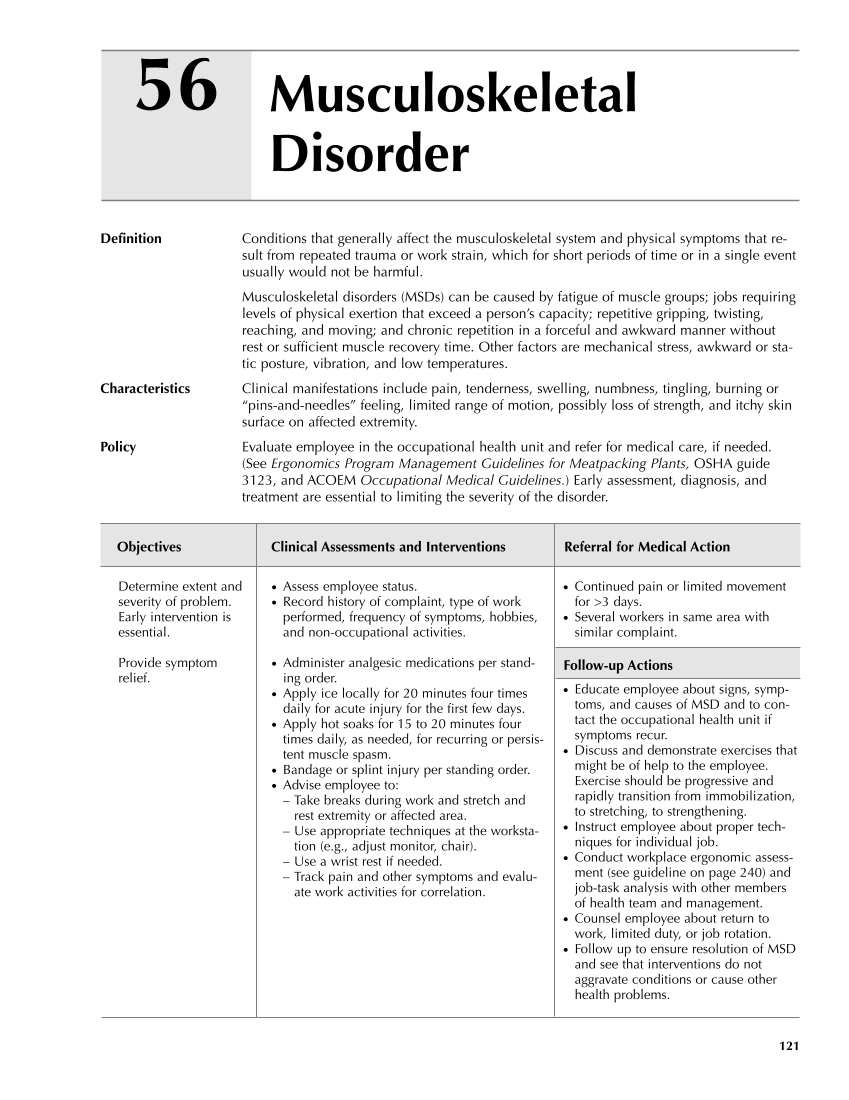121 Musculoskeletal Disorder 56 Definition Conditions that generally affect the musculoskeletal system and physical symptoms that re- sult from repeated trauma or work strain, which for short periods of time or in a single event usually would not be harmful. Musculoskeletal disorders (MSDs) can be caused by fatigue of muscle groups jobs requiring levels of physical exertion that exceed a person’s capacity repetitive gripping, twisting, reaching, and moving and chronic repetition in a forceful and awkward manner without rest or sufficient muscle recovery time. Other factors are mechanical stress, awkward or sta- tic posture, vibration, and low temperatures. Characteristics Clinical manifestations include pain, tenderness, swelling, numbness, tingling, burning or “pins-and-needles” feeling, limited range of motion, possibly loss of strength, and itchy skin surface on affected extremity. Policy Evaluate employee in the occupational health unit and refer for medical care, if needed. (See Ergonomics Program Management Guidelines for Meatpacking Plants, OSHA guide 3123, and ACOEM Occupational Medical Guidelines.) Early assessment, diagnosis, and treatment are essential to limiting the severity of the disorder. Objectives Clinical Assessments and Interventions Referral for Medical Action ● Continued pain or limited movement for 3 days. ● Several workers in same area with similar complaint. Follow-up Actions ● Educate employee about signs, symp- toms, and causes of MSD and to con- tact the occupational health unit if symptoms recur. ● Discuss and demonstrate exercises that might be of help to the employee. Exercise should be progressive and rapidly transition from immobilization, to stretching, to strengthening. ● Instruct employee about proper tech- niques for individual job. ● Conduct workplace ergonomic assess- ment (see guideline on page 240) and job-task analysis with other members of health team and management. ● Counsel employee about return to work, limited duty, or job rotation. ● Follow up to ensure resolution of MSD and see that interventions do not aggravate conditions or cause other health problems. Determine extent and severity of problem. Early intervention is essential. Provide symptom relief. ● Assess employee status. ● Record history of complaint, type of work performed, frequency of symptoms, hobbies, and non-occupational activities. ● Administer analgesic medications per stand- ing order. ● Apply ice locally for 20 minutes four times daily for acute injury for the first few days. ● Apply hot soaks for 15 to 20 minutes four times daily, as needed, for recurring or persis- tent muscle spasm. ● Bandage or splint injury per standing order. ● Advise employee to: – Take breaks during work and stretch and rest extremity or affected area. – Use appropriate techniques at the worksta- tion (e.g., adjust monitor, chair). – Use a wrist rest if needed. – Track pain and other symptoms and evalu- ate work activities for correlation.
Purchased from OEM Press by (ge corporate access). (C) 2013 OEM Health Information, Inc. All rights reserved.












































































































































































































































































































































































































































